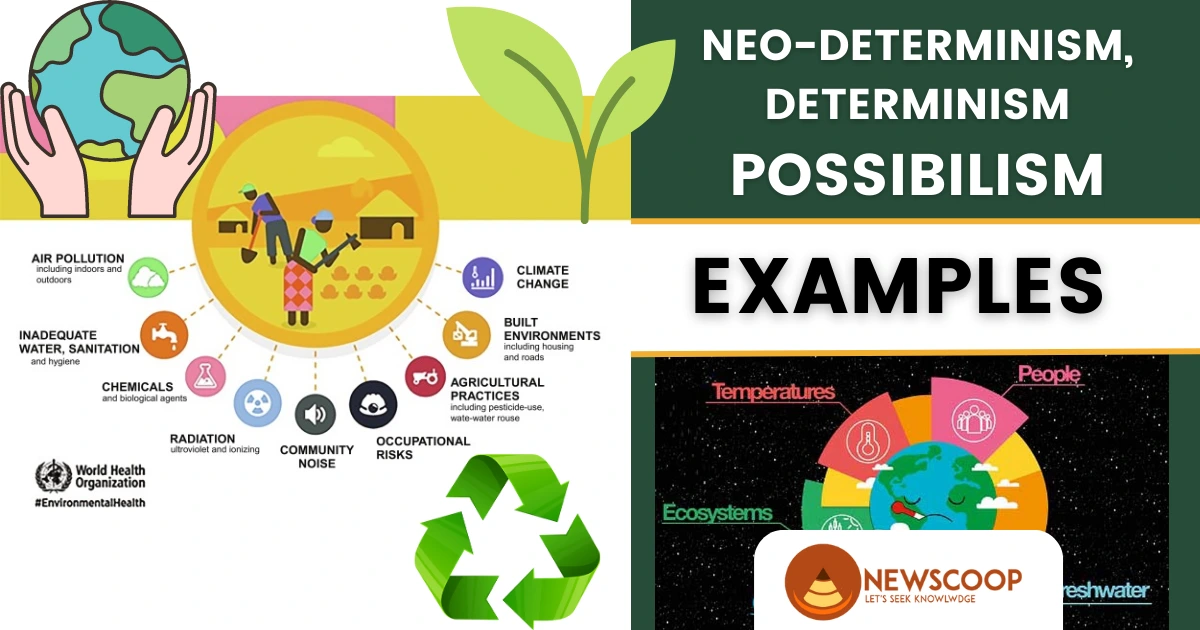Neo-Determinism, Determinism & Possibilism in Geography with Examples
In the realm of geography, understanding the intricate connections between humans and their environment is of paramount importance. Among the three major approaches in geography—are determinism, possibilism, and neo-determinism. Neo-determinism has emerged as a middle ground, offering a nuanced perspective on human-environment relationships.
This article explores the concept of neo-determinism, its origin, key features, and its significance in comprehending the complex dynamics shaping our world.
What is Determinism?
Determinism is an early geographical perspective that asserts the dominant influence of the physical environment on human behavior and societal development. It contends that environmental factors such as climate, topography, and resources determine human actions, leaving little room for human agency.
Example: Sahara Desert’s Impact on Human Settlement
Determinism suggests that the harsh conditions of the Sahara Desert in Africa, characterized by extreme heat and limited water sources, significantly limit human settlement. It is believed that the desert’s arid climate and lack of fertile land deter extensive human habitation in these regions.
What is Possibilism?
Possibilism emerged as a reaction to determinism, recognizing the role of human agency in shaping the environment and overcoming its constraints. It asserts that while the environment sets limitations, humans have the capacity to adapt, innovate, and modify their surroundings to suit their needs.
Example: Terrace Farming in Mountainous Regions
Possibilism is evident in terrace farming practices in mountainous regions such as the Philippines and China. Despite challenging topography, farmers create terraced fields to cultivate crops effectively. This showcases human ingenuity in adapting to environmental limitations.
What is Neo-Determinism?
Neo-determinism rejects the extremes of determinism and possibilism. It recognizes that human actions are not entirely determined by the environment, nor are they completely free from its influence. Instead, it emphasizes the interplay between human agency and environmental factors in shaping our world.
Further, Neo-determinism is often referred to as “Stop and Go Determinism.” It posits that while humans can innovate and adapt to their environment, there are limits to such activities. When human actions, such as excessive pollution or over-exploitation of resources, cause long-term damage to the environment, nature forces us to stop and adjust our behavior.
Origin of Neo-Determinism
The concept of neo-determinism was introduced by Griffith Taylor, an Australian geographer, who sought to bridge the gap between environmental determinism and possibilism.
While environmental determinism emphasized the environment’s total control over human activities, and possibilism argued for complete human freedom, neo-determinism proposed a more balanced and realistic viewpoint.
Examples of Neo-Determinism in Geography
- Urban Planning and Green Spaces: In modern urban planning, neo-determinism is evident in the integration of green spaces and parks into city designs. Planners recognize the importance of preserving natural environments and creating sustainable urban areas that promote well-being and mitigate environmental issues like pollution and heat islands.
- Renewable Energy Transition: The shift towards renewable energy sources, such as solar and wind power, demonstrates neo-determinism. While fossil fuels have long been the dominant energy source, the recognition of their detrimental impact on the environment has led to the adoption of cleaner alternatives that align with nature’s sustainable energy generation.
- Climate Change Adaptation Strategies: Governments and communities worldwide are developing climate change adaptation strategies based on neo-deterministic principles. These strategies aim to mitigate the effects of climate change by considering the limits and capabilities of the environment while incorporating human interventions to protect vulnerable populations and ecosystems.
- Conservation and Biodiversity: Neo-determinism plays a significant role in conservation efforts. By understanding the interdependence between human activities and biodiversity, conservationists implement measures to protect endangered species and preserve natural habitats while taking into account human needs and ecological balance.
- Sustainable Agriculture Practices: In agriculture, neo-determinism guides sustainable practices that minimize negative impacts on the environment. Techniques such as crop rotation, organic farming, and integrated pest management consider the ecosystem’s resilience and balance to ensure long-term agricultural productivity without depleting natural resources.
- Watershed Management: Neo-determinism is evident in watershed management initiatives. By assessing the limits and potential of the local hydrological system, communities can develop effective water conservation and purification strategies, promoting sustainable water usage and safeguarding ecosystems.
Conclusion
In conclusion, geography encompasses three fundamental approaches—determinism, possibilism, and neo-determinism. While determinism emphasizes environmental control, possibilism underscores human adaptability. Neo-determinism emerges as a crucial middle ground, offering a balanced and nuanced perspective on the complex interactions between humans and their environment.
By recognizing the interplay of human agency and environmental constraints, neo-determinism provides valuable insights for understanding and addressing the challenges of sustainable development and environmental stewardship in our world.
Thank You!

